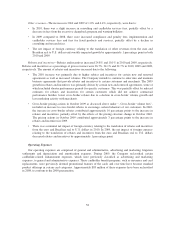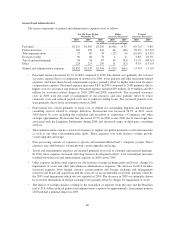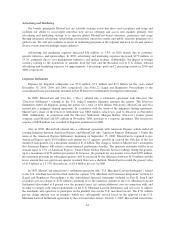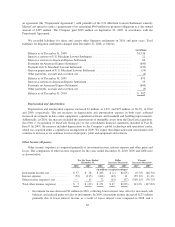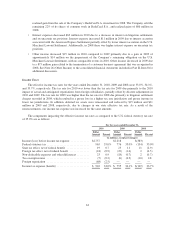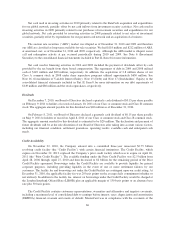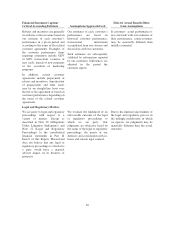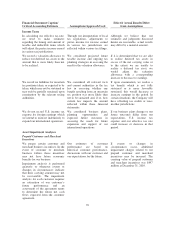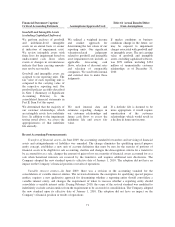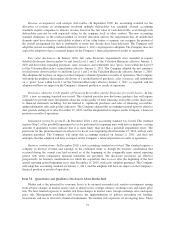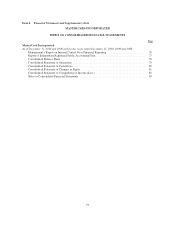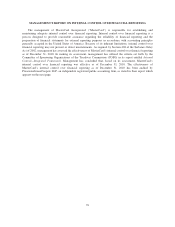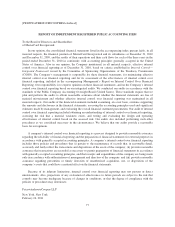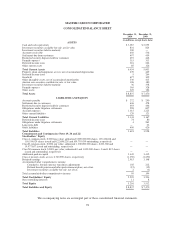MasterCard 2010 Annual Report Download - page 78
Download and view the complete annual report
Please find page 78 of the 2010 MasterCard annual report below. You can navigate through the pages in the report by either clicking on the pages listed below, or by using the keyword search tool below to find specific information within the annual report.
5Represents amounts due in accordance with the American Express Settlement and other litigation
settlements. The American Express Settlement requires two remaining quarterly payments in the first half of
2011 of $150 million each.
6Debt primarily represents amounts due for the acquisition of MasterCard France. We also have various
credit facilities for which there were no outstanding balances at December 31, 2010 that, among other
things, would provide liquidity in the event of settlement failures by our members. Our debt obligations
would change if one or more of our members failed and we borrowed under these credit facilities to settle on
our members’ behalf or for other reasons.
Seasonality
Historically, our quarterly gross revenues have been positively impacted in the fourth quarter by increases in
purchase volume related to the holiday shopping period, with corresponding higher rebates and incentives to our
customers. Also, operating expenses have historically been higher in the fourth quarter due to additional
advertising and promotions related to the holiday period. The economic crisis in 2008 caused our operating
results to diverge from these historical trends as gross revenues in the fourth quarter of 2008 were negatively
impacted by lower purchase volumes and transactions. In response, MasterCard accelerated its cost savings
initiatives in the quarter, with particular focus on advertising, personnel and travel expenses. The results for the
fourth quarters of 2009 and 2010 were more consistent with the historical trends.
Critical Accounting Estimates
Our accounting policies are integral to understanding our results of operations and financial condition. We
are required to make estimates and assumptions that affect the reported amounts of assets and liabilities, and
disclosure of contingent assets and liabilities, at the date of the financial statements, and the reported amounts of
revenue and expenses during the reporting periods. We have established detailed policies and control procedures
to ensure that the methods used to make estimates and assumptions are well controlled and are applied
consistently from period to period. The following is a brief description of our current accounting policies
involving significant management judgments.
Financial Statement Caption/
Critical Accounting Estimate Assumptions/Approach Used
Effect if Actual Results Differ
from Assumptions
Revenue Recognition
Domestic assessments require an
estimate of our customers’ quarterly
GDV or GEV to recognize quarterly
domestic assessments.
Domestic assessments included an
estimate representing 13% of total
domestic assessments in each of
2010, 2009 and 2008 and 6% of
total net revenues in 2010, 2009 and
2008.
Our revenue recognition policies are
fully described in Note 1 (Summary
of Significant Accounting Policies)
to the consolidated financial
statements in Part II, Item 8 of this
Report.
Customers’ GDV and GEV are
estimated by using historical
performance, transactional
information accumulated from our
systems and discussions with our
customers.
Such estimates are subsequently
validated against the GDV or
GEV reported by our customers.
Differences are adjusted in the
period the customer reports.
If customers’ actual performance is
not consistent with our estimates of
their performance, realized
revenues may be materially
different than initially estimated.
Historically, our estimates have
differed from the actual
performance by less than 5% of the
estimates on a quarterly basis.
68


